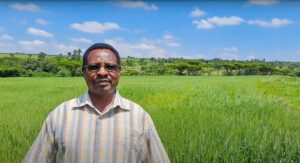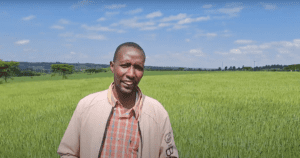scroll

Boomitra’s mission centers building farmer resilience against the growing inequity caused by climate change. We invite farmers and ranchers—of any size, crop type, or location—to participate in the voluntary carbon market, thanks to our proprietary technology and innovative business model. Explore the stories of two Boomitra carbon farmers from Kenya’s Narok county, Simion Ole Kiok and Dismus Pere, with landholding sizes of 250 acres and 70 acres, respectively. Simion and Dismus are two of 150,000 farmers enrolled in Boomitra’s projects.

Simion, a wheat and maize farmer from the Melelo ward of Narok South, is at the forefront of agricultural innovation in his community. Situated in a county with a diverse agricultural sector, encompassing both subsistence and commercial agriculture, Simion has embraced a range of regenerative practices to transform his 250-acre farm.
Simion reflects, “I did not know how to take care of my forests and the only practice implemented on the farms was conventional plowing. Ultimately, the produce grown on 100 acres of land was equivalent to that of 1 acre.”
Experts from Boomitra, partner organizations, and Kenya’s Ministry of Agriculture engaged farmers like himself in the subcounty and conducted training and feedback sessions on improved practices. “We have many indigenous trees on our land, which are excellent for carbon capture and storage,” explains Simion. “We also retain crop residue on the farm to improve soil fertility, and sometimes use it as livestock feed.” Besides crop residue management, Simion practices agroforestry, minimum tillage, crop rotation and rotational grazing. He also uses a chisel plow to prepare land. Unlike conventional plowing, chisel plow allows for greater moisture retention and decreased soil disturbance. Collectively, these practices contribute to increased land productivity and improved harvest yields.
While most of his harvest is for his household, Simion sells any surplus produce. He also relies on the sale of farm animals as an additional source of income. Beyond meeting expenses, Simion uses profits to engage with the community. He shares, “We hold farmer exhibitions after successful harvests. This enables other farmers from the community to showcase as well as see for themselves how new agricultural practices have improved farms and livelihoods.”
For the future, he hopes that more stakeholders will come together to help farmers improve yields and income, all the while building climate champions.

Dismus Pere from Olololunga, Narok South has been farming since 2013. Dismus first heard about Boomitra’s carbon farming program from onboarded farmers in the region. Motivated by the extensive erosion his soils were facing, he decided to transition his farming practices. Today, he practices crop rotation, controlled grazing, minimum tillage, residue management, cover cropping and agroforestry across his 70 acres of land.
Crop rotation between maize, beans, and potatoes, the primary crops on his farm, has become a cornerstone of Dismus’s farming strategy. He discovered that early land preparation for crops is instrumental to both managing weeds and controlling pests and diseases. Dismus uses a ripper to break up hardpan soil prior to planting. This ripper, unlike other tillage practices like plowing, minimally tills the soil, which prevents erosion, facilitates root penetration, and allows for more water to be stored in the rip lines – evenly spaced trenches created in a field for specific farm needs. Dismus enhances soil fertility by incorporating crop residue into the soil post-harvest, as opposed to burning it.
In the past two years, Dismus has already experienced increase crop health, yields, and profits on his farm. Passionate about sharing his knowledge, he organizes field days to train fellow farmers in climate-smart agriculture techniques. During these field days he explains the process of carbon credits, “We capture carbon and store it in the soil.” He hopes to encourage his peers to regenerate their soil and reap the benefits of carbon credit revenue.
Follow us on LinkedIn to meet more farmers and ranchers paving the way in soil regeneration.



